
Cox Model Engines
Encyclopedia
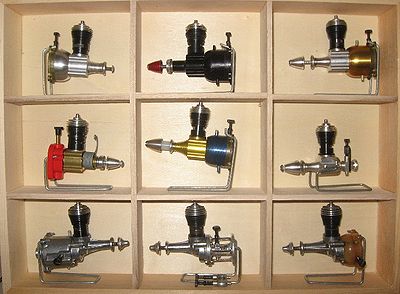

Model aircraft
Model aircraft are flying or non-flying models of existing or imaginary aircraft using a variety of materials including plastic, diecast metal, polystyrene, balsa wood, foam and fibreglass...
, model car
Model car
A model car or toy car is a miniature representation of an automobile. Other miniature motor vehicles, such as trucks, buses, or even ATVs, etc. are often included in the general category of model cars...
s and model boats. Cox engines were in production for more than 50 years between 1945 and 2006. The business gets its name from Leroy (Roy) M Cox
Leroy M Cox
Leroy Milburn Cox Known as Roy, he was an entreprenuer, world famous for his Cox model engines and gas powered toys including model cars, airplanes and boats.- Family History :...
, the founder. Roy Cox
Leroy M Cox
Leroy Milburn Cox Known as Roy, he was an entreprenuer, world famous for his Cox model engines and gas powered toys including model cars, airplanes and boats.- Family History :...
started L.M. Cox Manufacturing Co. Inc. who later became "Cox Hobbies Inc." and then "Cox Products" before being sold to Estes Industries
Estes Industries
Estes Industries is a company based in Penrose, Colorado, USA that designs and builds model rocket and model aircraft engines and kits. They were the best known model rocket company during the "golden age of rocketry" in the 1970s and early 1980s, competing primarily with Centuri Engineering and a...
when it became Cox Models
Cox Models
Cox Models, a former division of Estes Industries of Penrose, Colorado, was a multimillion-dollar hobby company, is one of the hobby industry's oldest companies and is noted for its production of miniature model internal-combustion engines....
. On February 7, 2009 Estes Industries stopped producing Cox engines and sold all of their remaining inventory i.e. mainly spare parts, to several private buyers from Canada and USA. One of the new owners of the remaining Cox engine and parts inventory has launched a website, Cox International with online store.
Millions of engines were produced and they became the most common 1/2A Class
Model engine classes
In the world of model aircraft there are several competition classes to signify engine displacement....
0.049 cubic inch engine in the world and probably still are today. Although the production of the engines ceased some years ago now, engines made as far back as the 1950s are still sold "as new" and in abundance on ebay world wide.
Cox history
The Cox range of model engines were the brain child of entrepreneur Leroy (Roy) M. Cox.- Cox Manufacturing started out in Leroy's garage in 1945 where he made wooden pop guns for kids and employed local housewives to assemble them. Metal was scarce due to the war which is why the toy guns were made of wood.
- In 1946 metal became readily available again and competitors quickly moved into the market making their metal pop guns cheaper, so Roy moved to something else, making metal tether cars for kids.
- In August 1946 a fire in Cox's garage forced him to move to newer and larger premises at 730 Poinsettia Ave, Santa Ana, CaliforniaSanta Ana, CaliforniaSanta Ana is the county seat and second most populous city in Orange County, California, and with a population of 324,528 at the 2010 census, Santa Ana is the 57th-most populous city in the United States....
.
- In 1947 Cox developed a racing car which used an engine manufactured by Cameron Brothers. The cars sold for $19.95 and generated $200,000 in sales in their first year of production.
- In 1949 Cox developed their own engine for their racing tether car which included some parts from Mel Anderson's Spitzy engine. This engine was called the "O Forty Five" as it was .045 cubic inch displacement.
- In 1950 with sales of the car proving to be a success Cox moved on to development of a model plane engine. Roy, felt the need for dependable, easy-to-start engines and spent the better part of the year 1950 in research. (actually 8 months) His three man engineering crew (himself, Mark Mier and Bill Fogler) spent 7 days a week, day and night, to develop the ‘.049 Space Bug’ contest engine. The end result was the Space Bug .049 Contest engine, Cox's first model plane engine which was completed in October 1951.
- In 1952 first name change was made to L.M. Cox Manufacturing Company Inc. The Space Bug engine sets the scene for all the Cox engines that followed and it went into full production in 1952. This engine was so popular that it caused problems for other model engine manufacturers.
- In 1953 Cox produced their first Ready To Fly (RTF) airplane the TD1 which was powered by the Space Bug engine.
- In 1953 Leroy Cox (L.M. Cox Manufacturing) is sued by Jim Walker (American Junior Aircraft Co.) for copyright infringement because Cox was using Walker's patented bellcrank system in the TD1 and secondly because Walker believed the Cox Skylon Reel was a copy of his U-Reely control handle. The court case lasted for 3 years.
- In 1955 Cox wins the court case against Jim Walker. Walker's patent on the bellcrank control system is ruled void and invalid because it was determined that the system had been designed before Walker's patent and by someone else - a man named Oba St.Clair, who was the first man to fly a control line airplane (in the USA) back in 1937 and the design was published in 1938. Oba St.Clair had shown his design to Jim Walker who took it upon himself to patent the design! The court also ruled that the Cox reel was not a copyright infringement.
- In 1956 Cox developed the Babe Bee 049, designed by William (Bill) Selzer, which had an extruded aluminum crankcase, not cast like the others, this engine sold for just $3.95 and stamped the final nail in the coffin of many competitors whose engines were selling for substantially more. The Babe Bee was a high quality high precision engine which started easily and was very reliable, unlike some of the competition.
- In 1957 Cox took over the Flying Circle at Disneyland which was a major coup for the company. The model planes were being flown each day in front of tens of thousands of people and they had a hobby shop right there full of Cox RTF planes. The Cox Flying Circle http://davelandweb.com/tomorrowland/flightcircle.html remained in operation until 1965 when it was closed to make way for expansion of Tomorrowland.
- In 1960 Cox hired an engineer named Bill Atwood, (who had already build his own line of engines), to develop a new .010 cubic inch engine. Atwood was also responsible for the Tee Dee and Medallion line of engines. These engines put Cox on the map as a leading engine in the world for many years to come.
- In 1963 due to continuing growth the company moved to larger (225,000 square feet) facilities which were three times larger than the old site. Shortly thereafter Cox got into Slot Cars and focused attention on gearing up for this fad.
- 1965 Cox International is established in Hong KongHong KongHong Kong is one of two Special Administrative Regions of the People's Republic of China , the other being Macau. A city-state situated on China's south coast and enclosed by the Pearl River Delta and South China Sea, it is renowned for its expansive skyline and deep natural harbour...
to meet the demands of the Slot Car craze.
- 1967 The Slot Car fad ends, leaving Cox with excess stock that cannot be sold resulting in financial cash flow problems.
- In 1969 Leroy's wife Myrtle died and Leroy was having health problems of his own so he retired and sold the company to Leisure Dynamics Inc. Leisure Dynamics continued to expand the range of Cox Model Aircraft as well as adding trains, boats, rockets, kites and radio control boosting sales to 25 million dollars per year. Roy Cox retired with the distinction of being the world's most successful model engine manufacturer.
- In 1970 William H. Selzer was appointed as President of L.M. Cox Manufacturing Inc. (a subsidiary of Leisure Dynamics).
- In 1971 Leisure Dynamics breaks the company in two and moves the model production to Minnesota and leaves the engine production in Santa Ana, California.
- In 1976 Leisure Dynamics changes the company name to "Cox Hobbies Inc."
- In 1980 Leisure Dynamics filed for bankruptcy, taking Cox Hobbies Inc. with them.
- In 1981 Leroy (Roy) M. Cox passed away Sept, 22. Age 75.
- In 1983 former Cox engineer and president Bill Selzer (whom Cox hired in 1952) purchased the company out of bankruptcy. All manufacturing was returned to Santa Ana. The company once again flourished into the 1990s with new products being added and another move to even bigger facilities.
- In 1990 Cox Hobbies moved to new facilities at Corona, CaliforniaCorona, CaliforniaCorona is a city in Riverside County, California, United States. As of the 2010 census, the city had a population of 152,374, up from 124,966 at the 2000 census...
.
- In 1993 the company name changed again to "Cox Products". The Pee Wee, Babe Bee, and PT 19 Trainer still in production.
- In 1995 Cox celebrated 50 years and introduced some new engines and RTF models.
- In 1996 Cox sold to Estes Industries / Centuri Corp. and moved to Penrose, ColoradoPenrose, ColoradoPenrose is a census-designated place in Fremont County, Colorado, United States. The population was 4,070 at the 2000 census. The Penrose Post Office has the ZIP Code 81240.-Geography:Penrose is located at ....
. Things changed quite considerably from here on. Cox as the hobbyists of the world knew it had gone. The high reputation Cox engines had declined. One by one each product item was withdrawn from sale as stock ran out. Engine parts from different engines were mixed and matched making hybrid engines that performed very poorly compared to the Cox engines from previous years. Estes added new products to the Cox line using the Cox name, however these were electric radio control models. Some of which were known to explode resulting in a massive product recall by the company.
- In 2005 an online company calling themselves Cox Hobby Distributors (owned by Estes Industries) appeared selling RC and electric products and some of the "classic" engines and RTF models. However as each item from the classic era sold out it wasn't replaced.
- In Feb. 2009 Estes Industries sold all of their remaining classic Cox stock to a private buyer from Canada. Bernie & Xena. In June 2009 they launched a website Cox International to sell the remaining stock online and also via eBay.
- In Jan. 2010 Estes-Cox Corporation purchased by HobbicoHobbicoHobbico, Inc. is located in Champaign, Illinois and is a manufacturer and distributor of hobby products including radio control airplanes, boats, cars and helicopters. Other products include plastic model kits, model rockets, model trains, slot cars, crafts, jigsaw puzzles and games...
based in Champaign, Illinois.
The engines
The Cox .049 Engine is a 2-stroke internal combustionInternal combustion engine
The internal combustion engine is an engine in which the combustion of a fuel occurs with an oxidizer in a combustion chamber. In an internal combustion engine, the expansion of the high-temperature and high -pressure gases produced by combustion apply direct force to some component of the engine...
glow plug engine. These engines use a glow plug to heat the fuel/air within the cylinder to start. Once running it is disconnected and operates in the same manner as a diesel engine. The self ignition is due to the heat produced from the compression of the air/fuel mix, and the catalytic reaction of the platinum element in the glow plug and the methanol in the fuel and does not depend in any way upon the continued use of the battery.
Fuel intake to the engine is controlled by a simple needle valve
Needle valve
A needle valve is a type of valve having a small port and a threaded, needle-shaped plunger. It allows precise regulation of flow, although it is generally only capable of relatively low flow rates.- Construction and operation :...
and venturi
Venturi effect
The Venturi effect is the reduction in fluid pressure that results when a fluid flows through a constricted section of pipe. The Venturi effect is named after Giovanni Battista Venturi , an Italian physicist.-Background:...
system. Fuel/air mixture
Air-fuel ratio
Air–fuel ratio is the mass ratio of air to fuel present in an internal combustion engine. If exactly enough air is provided to completely burn all of the fuel, the ratio is known as the stoichiometric mixture, often abbreviated to stoich...
intake to the crankcase
Crankcase
In an internal combustion engine of the reciprocating type, the crankcase is the housing for the crankshaft. The enclosure forms the largest cavity in the engine and is located below the cylinder, which in a multicylinder engine are usually integrated into one or several cylinder blocks...
is controlled via a reed valve
Reed valve
Reed valves are a type of check valve which restrict the flow of fluids to a single direction, opening and closing under changing pressure on each face...
or rotary valve depending on the engine design.
In a reed valve engine the valve is drawn open by suction as the piston
Piston
A piston is a component of reciprocating engines, reciprocating pumps, gas compressors and pneumatic cylinders, among other similar mechanisms. It is the moving component that is contained by a cylinder and is made gas-tight by piston rings. In an engine, its purpose is to transfer force from...
moves upward on the compression stroke. As the piston moves down on the power stoke, the pressure in the crankcase causes the reed valve to close. The fuel air mixture in the crankcase is then forced past the piston via the transfer/bypass ports in the cylinder. One characteristic of a reed valve is that the engine will run in either direction; an advantage for a "pusher" model but a disadvantage if the engine is finger started, as it may start in the wrong direction. (The Cox engines employed a starting spring which kept fingers free of the propellor and generally ensured correct rotational direction.)
On rotary valve engines the process is similar except instead of a reed, a rotary valve is used (incorporated in the crankshaft), which opens and closes as the piston moves up and down. The rotary valve is more efficient and adjustable (at design time) as there is a larger and clearer path to the crankcase than in the reed valve setup, but such engines can run in only one direction; pusher configurations require a special propellor, sometimes difficult to find.
The fuel
Fuel
Fuel is any material that stores energy that can later be extracted to perform mechanical work in a controlled manner. Most fuels used by humans undergo combustion, a redox reaction in which a combustible substance releases energy after it ignites and reacts with the oxygen in the air...
used to power the engine is called Model Engine Fuel, a mixture of methanol
Methanol
Methanol, also known as methyl alcohol, wood alcohol, wood naphtha or wood spirits, is a chemical with the formula CH3OH . It is the simplest alcohol, and is a light, volatile, colorless, flammable liquid with a distinctive odor very similar to, but slightly sweeter than, ethanol...
(70%-40%), castor oil
Castor oil
Castor oil is a vegetable oil obtained from the castor bean . Castor oil is a colorless to very pale yellow liquid with mild or no odor or taste. Its boiling point is and its density is 961 kg/m3...
(20%) and nitromethane
Nitromethane
Nitromethane is an organic compound with the chemical formula . It is the simplest organic nitro compound. It is a slightly viscous, highly polar liquid commonly used as a solvent in a variety of industrial applications such as in extractions, as a reaction medium, and as a cleaning solvent...
(10%-40%).
The Cox line of reed valve engines designed prior to 1960 used a rear reed valve induction system. In the late 1950s they played around with rear rotary valve induction (as used in the RR1) before moving forward with front rotary valve induction for their Tee Dee and Medallion lines.
Early engines

- 1949 O Forty Five Power Pak (Special Racer Car Engine #PP-45 - Manufactured 1949)
This engine was the first designed by Cox but included some major parts (i.e. piston and cylinder) of the Spitzy .045 engine designed by Mel Anderson. It employed a twin reed valve which was later used for the Space Bug. The engine was a major engineering achievement for its time, by incorporating reduction gears, fuel tank, flywheel and muffler all into one "Power Pak." The air intake was via one of the axles.
- 1949 O Sixty Power Pak (Special Racer Car Engine #???? - Manufactured 1949)
When slightly more power was needed for the Thimble Drome Special car to obtain more speed, a slightly larger version of the .045 was ordered with a bigger bore making the displacement .060 cubic inches.
- 1952 Space Bug (Cat#349 - Manufactured 1952-1958)
The Space Bug was the first engine built entirely by Cox. It was designed for Control Line
Control line
Control line is a simple and light way of controlling a flying model aircraft. The aircraft is connected to the operator by a pair of lines, attached to a handle, that work the elevator of the model. This allows the model to be controlled in the pitch axis...
flying use only and was marketed as a "Competition" engine and sold for $6.95. Back then there was no market for Radio Control
Radio control
Radio control is the use of radio signals to remotely control a device. The term is used frequently to refer to the control of model vehicles from a hand-held radio transmitter...
and Free Flight
Free flight (model aircraft)
The segment of model aviation known as free flight is the original form of the aeromodeling hobby, extending back centuries.- Description :...
hadn't been considered by Cox at this time. The piston and cylinder were made from mild steel bar stock
Bar stock
Bar stock, also colloquially known as billet, is a common form of raw purified metal, used by industry to manufacture metal parts and products....
and the crankcase and fuel tank were cast aluminum.
- 1953 Thermal Hopper (Cat#360 - Manufactured 1953-1958)
The Thermal Hopper is basically a Space Bug without the fuel tank. It has a needle valve and venturi mounted on an aluminum plate instead. These were designed for free flight and could also be used for control line flying. It allowed the user to put a fuel tank of their choosing on. The engine output was recorded at 0.066 bhp @ 17,000 rpm with a torque of 4.5 Oz.in at 10,000 rpm.
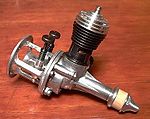
- 1953 Space Bug Jnr. (Cat#370 - Manufactured 1953-1958)
The Space Bug Junior is a Space Bug with a smaller plastic tank. This cheaper version also only had one intake bypass port and sold for $3.95.
- 1955 Strato Bug (Cat#380 - Manufactured 1955)
The same engine as a Space Bug but included a two piece fuel tank which was cheaper to make than the original space bug tank. The later Babe Bee tank was simply a further developed version of this tank. This engine was only produced during 1955 and sold as a mid range sport engine for $5.95. As such not many exist today which makes them very rare and collectible selling for over $300US in 2008.
Standard Bees
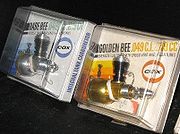
- 1956 Babe Bee 049 (Cat#350 - Manufactured Nov 1956-Jan 1996)
The classic Babe Bee was the first engine Cox produced with an extruded machined anodized bar stock aluminum crankcase. This crankcase was machine made and was much cheaper and faster to make than the cast aluminum crankcase of the earlier models. This engine was also supplied in thousands of RTF (Ready to Fly) airplanes sold in department stores worldwide. It has an integrated 5cc fuel tank. Max output power was recorded around 0.057 bhp (42 watts) @ 13,500 rpm on 15% nitro.
- 1957 Pee Wee .020 (Cat#100 - Manufactured Feb 1957-Jan 1996)
Buoyed with excitement of the Babe Bee 049 Leroy wanted to make a half size version of the Babe Bee. So he did. And they called it a Pee Wee .020, just like a Babe Bee only half the size.
- 1958 Golden Bee (Cat#120 - Manufactured Oct 1957-Jan 1980)
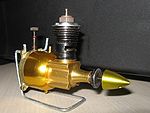
- 1966 QZ (Cat#450 - Manufactured 1966-1996)
QZ stands for Quiet Zone. It is a Babe Bee with a muffler, twin bypass port cylinder with no sub piston induction and a high compression (#1702) glow head. An attempt to regain the power loss caused by the muffler. Very similar to the later QRC engine which reportedly worked better. Cox also sold the muffler, cylinder and high comp. glow head components of the QZ as a Muffler Conversion Kit (Cat#495) for $2.98.
- 1976 QRC (Cat#450-1 - Manufactured 1976-1996)
The QRC was a modified Babe Bee engine that had a muffler and larger (8cc) fuel tank. In the 1970s noise became an issue and the Cox engineers discovered that when adding a muffler the engine would lose significant power. This problem was alleviated by installing a cylinder with no sub piston induction. The engine was designed for power launching Radio Controlled Gliders and had a red tank with a blue spinner.
- 1976 RC Bee (Cat#360 - Manufactured 1976-1996)
This engine was designed for small Radio Controlled model planes. It has a plastic clunk tank and an unusual cast crankcase. The Leisure Dynamics team thought that cast crankcases would be cheaper to produce, however they discovered that there were many manufacturing defects and they were difficult to machine, resulting in a high failure rate, so they returned to the tried and proven machined aluminum bar stock crankcase.
- 1982 Dragon Fly (Cat#4505 - Manufactured 1982-1996)
This engine was designed for the Radio Controlled model planes. It is basically a Baby Bee with a clunk tank and a muffler throttle.
- 1989 Texaco (Cat#4506 - Manufactured 1989-1996)
The is engine was designed for 1/2A Texaco RC duration competition. The engine has an additional fin on the larger glow plug which dissipates heat better allowing the engine to swing a larger propeller. i.e. 7 or 8 inches. This engine has a red 8cc fuel tank and a black crankcase. Original 1989 engines did not come out with 5 fin glow plug. The 5 fin glow plug came later in the 1992 Catalog.
- 1995 Texaco Jnr (Cat#4507 - Manufactured 1995-1996)
The same engine as the Texaco above except that it has a smaller 5cc fuel tank which is also red. First appeared in 1995 Cox Catalog.
High-performance Bees
- 1956 RR1 (Cat#390 - Manufactured 1956-1965)
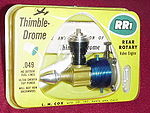
- 1959 Space Hopper (Cat#150 - Manufactured Nov 1958-1961)
The Space Hopper was Cox's first attempt at a beam mount engine plus the first steps towards their greatest engine, the Tee Dee. The engine was basically like the Thermal Hopper was to a Space Bug. That is a Babe Bee without a tank, but a venturi and needle valve relying on and external fuel tank. It is claimed it has as much power as a Tee Dee but how can this be if the Tee Dee was the most powerful engine? Anyway, this engine was short lived and made way for the Tee Dee in 1960. They look very retro and due to their apparent rareness are worth around $200US in 2008

- 1973 Black Widow (Cat#150 - Manufactured May 1973-Jan 1996)
During the 70s a couple of Cox engineers were playing around with different colored Babe Bee and Golden Bee parts and came up with an all black engine with a red spinner. They hopped it up a bit with a dual bypass cylinder from a Medallion, a black Golden Bee tank and a slightly larger (0.062") venturi intake. The Black Widow was born. These engines were marketed as a High Powered Combat Engine. On later Black Widows the red rubber spinner was replaced by a red anodized aluminum Tee Dee style spinner. In the late 1990s some Black Widows were produced with the a dual bypass slit exhaust cylinder. The slit exhaust was to prevent fires. According to an Aeromodeller engine test done in August 1974 the Black Widow on 25% Nitro output power was 0.08 bhp (60 watts) at 15,000 rpm with a max. torque of 6 oz.in at 9,000 rpm.
- 1995 Killer Bee 049 (Cat#340 - Manufactured 1995-1996)
The Killer Bee was a real good attempt at making a fast reed valve 049 engine from information that had been learned over the years of racing and competition. It had a tapered cylinder with SPI and lighter piston similar to the Tee Dee, a stronger balanced crankshaft and a new reed valve shape. They had a Yellow plastic needle valve. Later in 2002 Estes produced a Killer Bee that had none of these features but looked like the original Killer Bee except for the needle valve.
- 1996 Killer Bee 051 (Cat#360 - Manufactured 1996)
The Killer Bee 051 existed so that modelers could fly the same plane in two competition classes (i.e. A and 1/2A) simply by changing the engine. This engine has the same performance features as the 049 and the piston has two thin lines (or grooves) in the skirt for positive identification.
- 1996 Venom (Cat#140 - Manufactured 1996)

Tee Dees
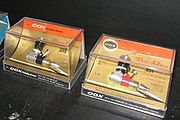
- 1961 Tee Dee 049 (Cat#170 - Manufactured Nov 1960-Jan 1996)
This is without a doubt, Cox's greatest and most famous engine. This engine was "THE" engine to use in competition for many years. It was designed by Bill Atwood who had been hired by Cox specifically to produce the Tee Dee line of competition engines.
The important features of the Tee Dee are as follows:
- Tapered cylinder and a lightened and tapered piston
- Result: tighter piston fit at TDC and less piston mass = more performance.
- Two deep bypass ports with two bypass booster grooves on each bypass port, extending slightly above the main bypass groove
- Result: significantly better air fuel mixture induction = more performance
- True peripheral venturi
- Result: more efficient fuel intake, fuel draw and induction = more performance
- Precision balanced and milled crankshaft
- Result: better fuel intake, better balanced engine = more performance
The Tee Dee was tested by Aeromodeller Magazine in 1962 and the output power was recorded to be .105 bhp (78 watts) @ 22,000 rpm with a max torque of 5.5 oz.in. at 18,000 rpm on 25% Nitro. (Note: The modern Norvel AME 049 engine which has a ceramic coated aluminum piston outputs .2 bhp (150 watts)@ 17,000 rpm). In 1973 the bypass porting, crank shaft timing and venturi were modified slightly and a mesh screen was added to the venturi to keep out dirt. This resulted in a minor performance improvement over the earlier versions.
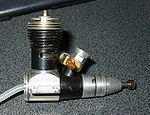
- 1961 Tee Dee 051 (Cat#200 - Manufactured Oct 1961-Jan 1996)
The 051 was simply a Class A version of the engine, physically the same on the outside only the bore was different and the piston had a small groove in the skirt to differentiate it from the 049. The 051 also had a RED carb body.
- 1994 Tee Dee .05 RC (Cat#201 - Manufactured 1994)
This engine had a proper RC carby and a full sized standard muffler and was designed specifically for RC flying. It had no Sub Piston Induction. Only two production runs of 1000 each were done so there are only 2000 of these in existence, making them the second rarest production engine next to the Venom. Note: Although the box said Tee Dee .05 the engine is actually .051
An .09 RC version also exists (Cat# 211 - Manufactured 1994 also)
- 1961 Tee Dee .010, .020, .09 & .15
Cox also built Tee Dee's in .010 (Cat#130), .020 (Cat#160), .09 (Cat#210) and .15 (Cat#180) size. All these engines were very successful.
A little known fact was also this: One of the things Cox wanted Atwood to do was make him a .010 engine. Cox had already tried to halve the size of the Pee Wee .020 but couldn't get it to run for some reason. The suspicion surrounded a problem with the tiny reed valve. Atwood found that the front rotary valve worked well on the .010 size hence the .010 was born. Why? Because Leroy Cox wanted one.
Medallions
- 1961 Medallion 049 (Cat#240 - Manufactured Nov 1961-Jan 1996)
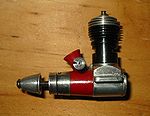
- 1961 Medallion .09 & .15
The Medallion engine was also produced in (Cat#230).09 and (Cat#220) .15 cubic inch size. There were also R/C versions of these ie Cat#230-1 Medallion .09 RC and Cat#220-1 Medallion .15 RC.
- 1995 Medallion 051 (Manufactured 1995)

Product engines
These are all variations of the Baby Bee with different back-plates and other parts designed for different RTF aircraft, cars and boats. There were literally hundreds of different models with subtle differences. Listed below are just a few of the more common ones.- 1959 Super Bee (Cat# 350-1)
Babe Bee with twin bypass cylinder to give more power for the P40 Warhawk RTF model. Early version had 'P40' stamped on the cylinder. It had a standard Babe Bee tank.
- 1964 Silver Bee (Cat# 350-6)
Similar to the Super Bee but it had a larger 8cc non-vented fuel tank. It did not have P40 stamped on the cylinder but it did have the twin bypass ports. This engine came with the Spitfire RTF airplane.
- 1962 Series 190 Product Engine (Cat#190)
Babe Bee with plastic backplate and brass needle valve. Various shapes were used depending on the model they were fitted to. Some had dual bypass port cylinders while others had single, it depended on the airplane.
- 1963 Series 290 / Spook Product Engine (Cat#290)
Came on a blister pack as a "Two Ninety" replacement engine. Basically a replacement 190 engine. An aluminum back plate was used for the "Spook" flying wing combat model kit engine (290-1).
- 2000 Surestart (Cat#191)
Another variation of the modern Babe Bee. These were pretty good because they have a choke tube attached to the grey plastic backplate. The choke tube makes the engine even easier to start. They were fitted to the very last RTFs (e.g. PT19 and Hyper Viper) before they went out of production.
Original Equipment Manufacturer (OEM) Engines
Over the years some Cox model engines were sold to other companies for use in their products and sold under the other companies names. Examples of these companies were, Testor Corporation, Sanwa & Kyosho of Japan, Johannes Graupner of Germany, Jerobee Industries trading as JoMac Products, Lite Machine Corporation and Tissan Haifa in Israel. Of all of the above mentioned companies, only Tissan Haifa assembled their own engines called the Banana .049. All the rest used motor manufactured by Cox themselves.- 1989 Cox Banana .049 (Cat#250)
This engine looked like a standard product engine with plastic backplate. It also had a spring starter, red aluminium spinner, and the fuel intake tube was extended below the plastic backplate. Cox also supplied a specially printed "Banana .049" box insert to fit their standard box.
Other Cox engines
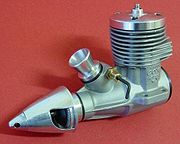
- 1959 Sportsman .15 (Cat# 110 Manufactured 1958-1961)
Rear reed valve .15 sized version of the Space Hopper
- 1959 Olympic .15 (Cat# 140 Manufactured 1959-1961)
Sportsman with twin ball races - designed for FAI Power FF event.
- 1961 Special .15 (Cat# 260 Manufactured 1962-1964)
Second version of Tee Dee 15 with thicker cylinder and wrist pin conrod instead of ball socket.
- 1964 Special .15 MkII (Cat# 270 Manufactured 1964-1968)
Third version of the Tee Dee .15 Single exhaust port Schnürle port intake system and gold crankcase.
- 1965 Olympic .15 Drum Valve
Prototyped only (50 made by Bill Atwood)
- 1968 Concept II .35 Front Rotary R/C (Cat# 2500 1968)
Prototyped only - Bill Atwood - Pictured in 1969 Dealer Catalog
- 1968 Concept II .35 Front Rotary Sport Engine (Cat# 2510 1968)
Prototyped only - Bill Atwood - Pictured in 1969 Dealer Catalog
- 1968 Concept II .40 Front Rotary R/C (Cat# 2520 1968)
Prototyped only - Bill Atwood - Pictured in 1969 Dealer Catalog
- 1968 Concept II .40 Rear Rotary R/C (Cat# 2530 1968)
Prototyped only - Bill Atwood - Pictured in 1969 Dealer Catalog
- 1976 Cox Conquest .15 (Cat# 2800 Manufactured 1976-1978)
This engine took over from the Tee Dee .15 as "THE" engine for FAI racing, combat and free flight for many more years until the Russian AAC Engines came along. This engine was patterned on the Australian designed 1973 Taipan 2.5cc Twin Ball Race engine by Gordon Burford
Gordon Burford
Gordon Burford was an Australian model engine designer and manufacturer. He was Australia's premier model engine builder. He produced thousands of engines of many different designs including the GeeBee, Sabre, GloChief and Taipan brands...
. The entire top end of the Cox Conquest and the Taipan TBR are interchangeable. Also came in R/C version Cat# 2810.
- 1976 Cox Conquest .40 - prototyped only
- 1987 Queen Bee .074 RC(Cat# 3701 Manufactured 1987)
Rear reed valve RC engine. Uses a standard glow plug. Power output is similar to Tee Dee .051. Came out Mid 1987 and is listed in Cox 1987 Catalog.
Cylinders
There were a wide range of cylinders produced with three different wall thicknesses. Most are interchangeable between all engine types which can create problems when buying a used engine. All early cylinders had a thin wall which was later found to need improvement because they bent easily in a crash or when trying to undo with a Cox wrench. Some people refer to these as Mk1 cylinders. The next type was thickened at the exhaust ports and are also known by some people as Mk2. The third type was thick wall the way down from the cooling fins to the bottom. This one facilitated the exhaust throttle ring and some people refer to this as a Mk3 although Cox never referred to them like this.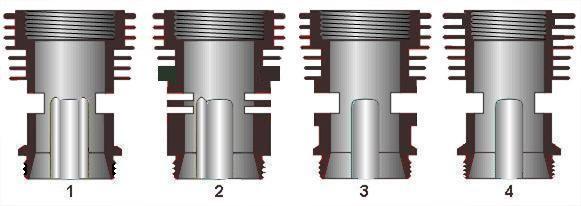
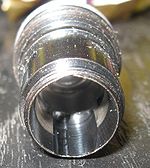
- depicts a thin wall Tee Dee .049 cylinder with dual booster ports on the bypass port.
- is a late model thick wall cylinder with slit exhaust and a single bypass booster.
- is a Black Widow #1 cylinder with no bypass booster with a stepped wall.
- is a pre-1955 cylinder used on early Space Bug, Space Bug Jr, Thermal Hopper and Strato Bug. Note how the thread diameter for the glow head is much smaller. No engines produced after 1955 used this cylinder.
The most powerful cylinder piston combination without a doubt is the number 4 Tee Dee 049 cylinder. This cylinder has a tapered grind and tapered and lightened piston so the piston fit gets tighter as the piston reaches top dead center (TDC). The intake or bypass porting is 2 deep ports with 2 bypass booster ports on each bypass. This setup causes a swirling of the intake fuel air mixture which promotes better combustion. The Tee Dee cylinder was the basis for the design of the Venom and Killer Bee Cylinders.
| Engine | Exhaust Ports | Bypass Ports | Bypass Boosters | SPI | Tapered Grind | Number on cyl. |
|---|---|---|---|---|---|---|
| Space Bug | Open | 2 | 0 | Yes | No | None |
| Thermal Hopper | Open | 2 | 0 | Yes | No | None |
| Space Bug Jnr | Open | 1 | 0 | Yes | No | None |
| Space Hopper | Open | 2 | 0 | Yes | No | None |
| Strato Bug | Open | 2 | 0 | Yes | No | None |
| Product Engine | Open | 1 | 0 | Yes | No | 2 |
| SureStart | Slit | 2 | 1 | No | No | None |
| Babe Bee | Open | 1 | 0 | Yes | No | 2 |
| Golden Bee | Open | 1 | 0 | Yes | No | 2 |
| Black Widow pre 96 | Open | 2 | 0 | Yes | No | 1 |
| Black Widow post 96 | Slit | 2 | 1 | No | No | None |
| Texaco | Slit | 2 | 1 | No | No | None |
| QRC pre 96 | Open | 2 | 0 | No | No | 6 |
| QRC post 96 | Slit | 2 | 0 | No | No | None |
| Killer Bee ‘96 | Slit | 2 | 1 | Yes | Yes1 | None |
| Killer Bee ‘02 | Slit | 2 | 1 | No | No | None |
| Venom | Open | 2 | 1 | Yes | Yes1 | None |
| Medallion pre 96 | Open | 2 | 0 | Yes | No | 1 |
| Medallion post 96 | Slit | 2 | 0 | No | No | None |
| Medallion 051 | Slit | 2 | 1 | No | No | 7 |
| Tee Dee 049 | Open | 2 | 2 | Yes | Yes2 | 4 |
| Tee Dee 051 | Open | 2 | 2 | Yes | Yes | 5 |
Notes:
SPI = Sub Piston Induction
1 The Killer Bee and Venom had a special competition lightweight piston and a heavy duty crank shaft for speeds above 22K rpm.
2 The Tee Dee also had a lightweight tapered piston and the crank was stronger and ported different to the Medallion crank.
Pistons
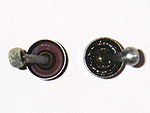
The engines that used the early style three piece piston are any engines produed prior to 1957. i.e. Space Bug, Space Bug Jnr, Thermal Hopper and Strato Bug. Since the Space Bug, Space Bug Jr and Thermal Hopper where produced up until 1958 you will find versions of these early engines around with the later style pistons. (and cylinders)
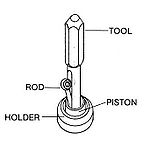
Piston / Conrod ball socket joint free play
Sometimes, especially with engines that have had a lot of use, the piston / conrod ball socket joint is very loose and will adversely affect performance. A Cox “reset” tool, available for the 020, 049/051 and the 09 series engines, is used to tighten the ball joint back up again. The correct free play is .001 to .003 inches. The .15 engines use a wrist pin so a socket reset tool is not required for these.Crankshafts
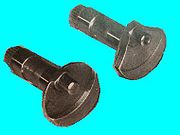
- All Bees with the exception of the Killer Bee and Venom had the same crankshaft that was only good for about 20,000 rpm before the conrod pin would break off.
- The Killer Bees and Venom had a heavy duty balanced and lightened crankshaft that improved performance and could withstand speeds in excess of 22,000 rpm.
A company named Davis Diesel Development in the USA also make a similar crankshaft called a Killer crank for their diesel conversions. They found under the heavier torque loads caused by running diesel fuel, that the pins would break also; hence they produced their own killer crank. The same Killer cranks are now being produced again by Cox International.
On the Tee Dees and Medallions the cranks are also interchangeable but quite different. The Tee Dee has a large square hole at the intake end of the crank whereas the Medallion has a smaller round hole. The timing is also different. On the later TD RC versions, the crankshaft is lightened and strengthened similar to the Killer Bee crank. i.e. ground away and hole in conrod pin.
Cox Glow Heads
There were 5 main types of Cox Glow Heads produced for the Cox 049: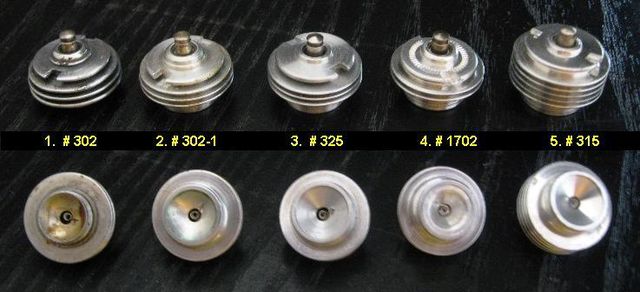
- #302 Pre 1955 Standard Head - Hemispherical shape - Low Compression - Smaller dia. threads - used on Space Bug, Thermal Hopper, Space Bug Jnr and Strato Bug Only.
- #302-1 Post 1955 Standard Head - Hemispherical shape - Low Compression - Larger dia. threads - used on all engines produced post 1955 until the #325 head was produced in 1979.
- #325 Standard Head - Hemispherical shape - Low Compression - Larger dia. threads - used on all post 1956 engines except Tee Dees, QZ, Killer Bees, Venom and Texaco. Replaced 302-1 head in 1979.
- #1702 Hi Compression Head - Trumpet shaped - High Compression - knurled top - 3 fins on early, 2 fins on later - used on Tee Dees, Killer Bees, QZ and Venom
- #315 Texaco Head - Hemispherical shape - Low Compression - 5 fins - used on Texaco Engine only. Supposedly allows greater cooling for engine when swinging larger propellers.
There are some minor variations to the above mentioned heads including different thickness cooling fins and thicker centre electrodes on later model OEM glow plugs however the internal shape and glow plug filament remained the same.
Special glow heads
Along the way there were also some special heads made:- #302RH 1953 Racing Head - Hemispherical shape - High Compression - Smaller dia. threads as used on Space Bug, Thermal Hopper, Space Bug Jnr and Strato Bug Only.
- #??? "W" element Standard Head - Hemispherical shape - Low Compression - Larger dia. threads. The concept was borrowed from either Atwood or Holland engines and Cox lost the ensuing patent fight therefore the production run was very short due to the legal situation.
- #331 & #335 Special 1 fin car head. This head was built for the 1992 Cox GTP Nissan, Stocker and Indy Car engines. The engine used a purpose built heat sink assembly with cooling fins Cat#1972
Aftermarket glow heads
- Standard glow plug head—uses standard conventional glow plug—low compression—standard performance
- Turbo glow plug head—low compression—medium performance
- Norvel Freedom Glow Plug—high compression—high performance—rare and hard to get.
- Galbreath Head with Nelson Plug Combo—high compression—high performance—most popular, gives the engine an immediate performance boost by up to 2,500 rpm depending on the engine.
- Cox International Insert Style glow head—Available in both Standard and Texaco style
Reed valves

- Early engines—Space Bug, Thermal Hopper, Strato Bug—circular twin copper reeds
- Bee Engines prior to 1989—star shaped single beryllium copperBeryllium copperBeryllium copper , also known as copper beryllium, beryllium bronze and spring copper, is a copper alloy with 0.5—3% beryllium and sometimes with other alloying elements. Beryllium copper combines high strength with non-magnetic and non-sparking qualities. It has excellent metalworking, forming...
reed held in place by a circlip reed retainer. (see image on left) - Later Bees, Killer Bees, Venom (post 1989) —oval shaped stainless steelStainless steelIn metallurgy, stainless steel, also known as inox steel or inox from French "inoxydable", is defined as a steel alloy with a minimum of 10.5 or 11% chromium content by mass....
reed which is held in place by a plastic reed retainer. (see image on right)
Later variants of the star and oval reeds were made of Mylar and Teflon. Some say Mylar is the best while others prefer the stainless steel and then others prefer the Teflon. Claims are that Mylar and Teflon are lighter and make the engine easier to start and go faster, but they do not last as long as the stainless ones.
Propellers
049 engines run well on a 5x3 to 6x3 prop. A 5.7x3 APC works well. To get any suitable speed for mouse racing a 4 inch pitch prop is required at high revs but to do this plenty of nitro-methane is also required, for example, a 4.75 X 4 prop with 40% Nitro. Texaco engines are designed to use bigger props. e.g. 7x4Fuel
The highest performance is achieved with fuel of 30% or more nitro content. At least 20% oil (50/50 castor/synthetic) is required. With high NitromethaneNitromethane
Nitromethane is an organic compound with the chemical formula . It is the simplest organic nitro compound. It is a slightly viscous, highly polar liquid commonly used as a solvent in a variety of industrial applications such as in extractions, as a reaction medium, and as a cleaning solvent...
(nitro) fuel it may be necessary to lower the compression by installing up to six or more additional head gaskets.
When using Castor Oil
Castor oil
Castor oil is a vegetable oil obtained from the castor bean . Castor oil is a colorless to very pale yellow liquid with mild or no odor or taste. Its boiling point is and its density is 961 kg/m3...
it is advisable to clean the engine cylinder wall with a Scotch-Brite pad to remove castor oil varnish buildup that will occur, especially after lean running. This buildup of varnish will cause the engine to run inconsistently.
To avoid this problem, it is advised to use a Synthetic oil
Synthetic oil
Synthetic oil is a lubricant consisting of chemical compounds that are artificially made . Synthetic lubricants can be manufactured using chemically modified petroleum components rather than whole crude oil, but can also be synthesized from other raw materials...
or synthetic and castor oil blend. Synthetic oil
Synthetic oil
Synthetic oil is a lubricant consisting of chemical compounds that are artificially made . Synthetic lubricants can be manufactured using chemically modified petroleum components rather than whole crude oil, but can also be synthesized from other raw materials...
contains detergents that will keep the cylinder wall clean, however these small engines do rely on some castor oil buildup to maintain high compression at higher running temperatures.
Using clean fuel and keeping everything clean and free from dust and dirt particles is also very important for consistent running in an engine of such small size as these.
Cox Fuel Formula
| Fuel Name | Methanol | Nitro-methane | Castor Oil | Klotz Oil |
|---|---|---|---|---|
| Glow Power | 70% | 10% | 18% | 2% |
| Flight Power | 65% | 15% | 18% | 2% |
| Race Power | 50% | 30% | 18% | 2% |
Diesel conversion
Davis Diesel Development http://davisdieseldevelopment.com/ manufactures and sells heavy duty Bee cranks (Killer cranks) and diesel conversion heads. These can be purchased direct from their web site or from eBay. The DD cranks are similar to the original Cox Killer Bee crank.Use in Radio Controlled Models
At the time Cox developed the first Cox engines, they were used in Control lineControl line
Control line is a simple and light way of controlling a flying model aircraft. The aircraft is connected to the operator by a pair of lines, attached to a handle, that work the elevator of the model. This allows the model to be controlled in the pitch axis...
and Free flight
Free flight (model aircraft)
The segment of model aviation known as free flight is the original form of the aeromodeling hobby, extending back centuries.- Description :...
model planes as there was no market for throttled Radio Control
Radio control
Radio control is the use of radio signals to remotely control a device. The term is used frequently to refer to the control of model vehicles from a hand-held radio transmitter...
engines back then. Radio Control, although first developed in the 1890s it was not available for model airplanes until the 1950's and did not become economically viable for small model planes until the mid-1970s and even then was for the modelers who could afford it. It was certainly out of reach of the hands of most children.
From the mid-1960s Cox produced throttle control devices for some of their engines, however these were not as effective as throttles on other brand engines as the Cox throttle worked by restricting exhaust flow. Exhaust throttles were produced for most Bee and all Medallion engines but not Tee Dee.
It wasn't until 1988 that Cox produced an engine with a true R/C carburetor and that engine was the Queen Bee .074. Then in 1994 Cox finally produced the Tee Dee .05 and .09 which both had a conventional R/C carburetor, with adjustable airbleed, and a full muffler.
In 2010, an after market R/C throttle/choke has been developed for the .049 reed valve engines. This throttle is attached to the choke tube on Sure Start .049 engines and can also be adapted to fit .049 reed valve engines with an integral tank. The throttle was developed by Saras Associates and is being marketed through Cox International.
Cox Ready to Fly Model Airplanes
Over the years, as well as producing millions of model engines Cox also produced a similar number of Ready To Fly (RTF) airplanes, as well as boats, cars, helicopters, trains, etc.The following is a list of the RTF airplanes produced by Cox between 1953 and 1978:
| Year | Model | Cat. # | Engine | Notes |
|---|---|---|---|---|
| 1953 | TD1 | 400 | Space Bug .049 | Cox's first RTF |
| 1954 | TD3 | 600 | Space Bug Jnr .049 | |
| 1956 | TD4 Trainer | B51, 5100 | 350 Babe Bee .049 | |
| 1957 | Super Cub 105 | C52, 5200 | 350 Babe Bee .049 | Replaced by the Super Cub 150 |
| 1958 | Lil Stinker | D53, 5300 | 100 Pee Wee .020 | First 020 powered plane |
| 1958 | Super Sabre | E54, 5400 | 100 Pee Wee 0.020 | |
| 1959 | P40 Warhawk | 5500 | 350-1 Super Bee .049 | Dual bypass port Babe Bee |
| 1960 | Commanche | 5600 | 110-1 0.15 Sportsman | Larger 2.5cc engine for Dads |
| 1960 | PT-19 Trainer | 5700 | 350 Babe Bee .049 | Also came out in 5710, 5761, 5900 and 6300 |
| 1960 | Curtiss Pusher (Kit) | 5800 | 350-2 Babe Bee .049 | First kit form RTF |
| 1961 | Avion Shinn 2150-A | 6200 | 190 Product Engine | |
| 1962 | Ju87D Stuka | 6400 | 190-1 Product Engine | 190-1 has a dual bypass cylinder - drops bomb |
| 1962 | Avion P51B Bendix Trophy Racer | 6600 | 190-2 Product Engine | Special backplate and needle valve |
| 1962 | Super Cub 150 | 5200 | 190-4 Product Engine | Updated version of earlier Super Cub 105 |
| 1963 | Curtiss SB2C Helldiver | 7000 | 190-3 Product Engine | 190-3 also has dual bypass - pilot bails out |
| 1963 | L-4 Grasshopper | 7200 | 190-4 Product Engine | |
| 1963 | Spook | 7420 | 290 Spook Engine | Flying wing (kit form) |
| 1963 | Avion P51B Mustang | 7600 | 190-2 Product Engine | Special backplate and needle valve |
| 1964 | P40 Kittyhawk | 8400 | 350-1 Super Bee .049 | RAF version of P40 Warhawk |
| 1964 | Spitfire | 7800 | 350-6 Silver Bee .049 | First version of Spitfire replaced in 1966 |
| 1965 | Curtiss A-25 Bomber | 7100 | 190-3 Product Engine | Dive bomber - drops bombs in flight |
| 1966 | RAF Spitfire | 7800 | 350-6 Silver Bee .049 | 2nd version with RAF colour scheme |
| 1966 | T-28 | 7900 | 290 Product Engine | |
| 1966 | QZ PT-19 Trainer | 5900 | 450 QZ .049 | PT-19 with QZ engine |
| 1967 | AD-6 Skyraider | 9700 | 190-6 Product Engine | |
| 1968 | F2G-1 Corsair | 7500 | 290 Product Engine | #7562 with flying accessories |
| 1968 | Pitts Special | 5300, 8200 | 100 Pee Wee 020 | Variation of the lil Stinker |
| 1969 | Thompson Trophy Corsair 27 | 2900 | 290 Product Engine | |
| 1969 | Red Baron | 5300 | 100 Pee Wee 020 | Also released as "Red Knight" |
| 1969 | Mini Stunt Biplane | 7300 | 100 Pee Wee 020 | Another version of the lil Stinker |
| 1969 | Ryan ST-3 Super Sport | 6200 (&6200-80) | 90-1 Pee Wee 020 | also available in trottled version 6200-80 |
| 1969 | Ryan PT Army Trainer | 6300 (&6300-80) | 100 Pee Wee 020 | same as 6200 & 6200-80 but in Army colors |
| 1970 | Corsair II | 3900 | 290 Product Engine | Chrome plated - left hand prop. |
| 1971 | Acro Cub | 4600 | 190-4 Product Engine | variant of the Super Cub |
| 1971 | Rivets | 6800 | 350-9 Product Engine | popular design sought by collectors |
| 1971 | P51D Miss America Mustang | 6900 | 190-7 Product Engine | Stars and stripes color scheme |
| 1971 | P51D Mustang | 7600 | 190-6 Product Engine | bubble canopy |
| 1972 | Sopwith Camel | 8000 | 191-0 Product Engine | |
| 1972 | Fokker DVII | 8100 | 191-2 Product Engine | |
| 1972 | Fokker DR1 Triplane | 8300 | 191-0 Product Engine | |
| 1973 | Super Sport Trainer | 8600 | 191-3 Product Engine | Pink aerobatics trainer |
| 1973 | Bushmaster | 8700 | 190-4 Product Engine | convertible with floats and skis |
| 1974 | Super Stunter | 5400 | 191-2 Product Engine | First design with foam wings |
| 1975 | Sky-Copter | 7100 | 100 Pee Wee 020 | First helicopter (free flight) |
| 1975 | Cessna 150 | 4000 | 191-8 Product Engine | Sure Flyer with autopilot |
| 1975 | Piper Comanche | 4100 | 191-8 Product Engine | Sure Flyer with autopilot |
| 1975 | Combat Mustang | 7700 | 191-x Product Engine | 2 speed throttle control |
| 1975 | Super Chipmunk | 9300 | 191-x Product Engine | Foam wing stunter |
| 1976 | Skymaster | 4200 | 191-8 Product Engine | Sure Flyer with autopilot |
| 1976 | P-39 Airacobra | 4300 | 191-8 Product Engine | Sure Flyer with autopilot |
| 1976 | Crusader Stunt Trainer | 9000 | 191-9 Product Engine | Foam wing stunter |
| 1977 | Wings F-15 Eagle | 3310 | 192-3 Product Engine | One piece beginner plane |
| 1977 | Wings Hustler | 3315 | 192 Product Engine | One piece beginner plane |
| 1977 | Wings F-15 Falcon | 3320 | 192-3 Product Engine | One piece beginner plane |
| 1977 | Wings Mantis | 3325 | 192 Product Engine | One piece beginner plane |
| 1978 | Star Cruiser UFO | 7200 | 049 Product Engine | Free Flight |
Notes:
Part numbers appear to skip and jump, however cars and boats produced around same times had numbers similar to the airplanes, therefore causing gaps. (see "Other Cox Toys" below)
Other Cox Toys
Over the years, Cox also produced a range of model cars and boats.The following is a list of cars and boats produced by Cox between 1954 and 1976:
| Year | Model | Cat. # | Engine | Notes |
|---|---|---|---|---|
| 1954 | Prop Rod | 900 | Space Bug Jnr .049 | Cox's first air propelled car. |
| 1956 | Prop Rod | 900 | 350 Babe Bee .049 | engine changed to Babe Bee |
| 1956 | Water Wizard Hydroplane | A50, 5000 | 350 Babe Bee .049 | Cox's first boat. |
| 1960 | Mercedes-Benz W-196 | 6000 | 350-3 Babe Bee .049 | First Babe Bee car engine |
| 1964 | Buick Riviera | 8240 | 350-4 Babe Bee .049 | |
| 1964 | Corvette Sting Ray | 8640 | 350-5 Babe Bee .049 | |
| 1964 | Ford GT Le Mans MkII | 8940 | 350-5 Babe Bee .049 | |
| 1965 | Chaparral | 9340 | 350-7 Babe Bee .049 | Authorized by Jim Hall |
| 1967 | American Eagle Indy Racer | 9640 | 350-8 Babe Bee .049 | Authorized by Dan Gurney |
| 1968 | Shrike | 9100 | 350-P Baby Bee .049 | Inverted engine |
| 1969 | Dune Buggy | 3700 | 350-4 Babe Bee .049 | Pull Starter |
| 1969 | Group 7 Road Racer | 9340 | 350-7 Babe Bee .049 | Same as Chaparral |
| 1969 | Eagle Indy Car (Blue) | 9640 | 190-6 Product Engine .049 | plastic back plate |
| 1969 | Eagle Indy Car (Red) | 4500 | 190-6 Product Engine .049 | |
| 1969 | Sea Bee Boat | 2800 | 350-3 Babe Bee .049 | Pull starter |
| 1969 | VW Baja Bug | 6000 | 350-4 Babe Bee .049 | Pull Starter |
| 1969 | AA/Fueler Dragster | 6100 | 190-8 Product Engine .049 | |
| 1970 | Chopper | 6700 | 350-8 Babe Bee .049 | Pull Starter |
| 1972 | Pinto Funny Car | 6500 | 190-5 Product Engine .049 | |
| 1972 | Vega Funny Car | 6600 | 190-5 Product Engine .049 | |
| 1972 | Sandblaster | 8400 | 190-5 Product Engine .049 | |
| 1972 | Ski Doo Snow Mobile | 8500 | 190-9 Product Engine .049 | |
| 1972 | Command Jeep | 8800 | 191-4 Product Engine .049 | |
| 1972 | Chopper II | 4400 | 350-8 Babe Bee .049 | |
| 1973 | Action Van | 4500 | 191-6 Product Engine .049 | |
| 1974 | Matador Stocker | 4500 | Product Engine .049 | Pneumatic Control |
| 1974 | Adam 12 Patrol Car | 9400 | Product Engine .049 | |
| 1975 | Stinger Funny Car | 7900 | 190-2 Product Engine .049 | |
| 1976 | Vanblaster | 8410 | Product Engine .049 | Quick Start System |
| 1976 | Magblaster | 8420 | Product Engine .049 | Quick Start System |
See also
- Control line (model aircraft)Control lineControl line is a simple and light way of controlling a flying model aircraft. The aircraft is connected to the operator by a pair of lines, attached to a handle, that work the elevator of the model. This allows the model to be controlled in the pitch axis...
- Cox ModelsCox ModelsCox Models, a former division of Estes Industries of Penrose, Colorado, was a multimillion-dollar hobby company, is one of the hobby industry's oldest companies and is noted for its production of miniature model internal-combustion engines....
- Free flight (model aircraft)Free flight (model aircraft)The segment of model aviation known as free flight is the original form of the aeromodeling hobby, extending back centuries.- Description :...
- Model aircraftModel aircraftModel aircraft are flying or non-flying models of existing or imaginary aircraft using a variety of materials including plastic, diecast metal, polystyrene, balsa wood, foam and fibreglass...
External references
- Biography of Leroy M Cox
- The Cox Engines Museum
- Model Engine Collectors Journal
- American Model Engines Encyclopedia
- Yahoo 049 Collectors Forum
- Model Engineering and Model IC Engine Projects
- The Internet Craftmanship Museum - Cox
- Original Author: Warren Leadbeatter - Model Engine Collector - AUS-14782

